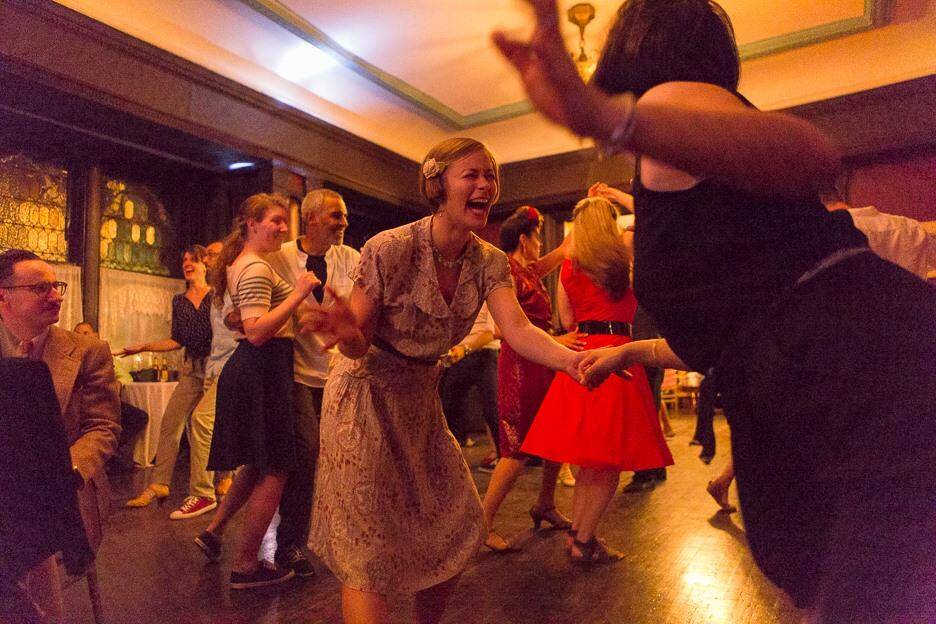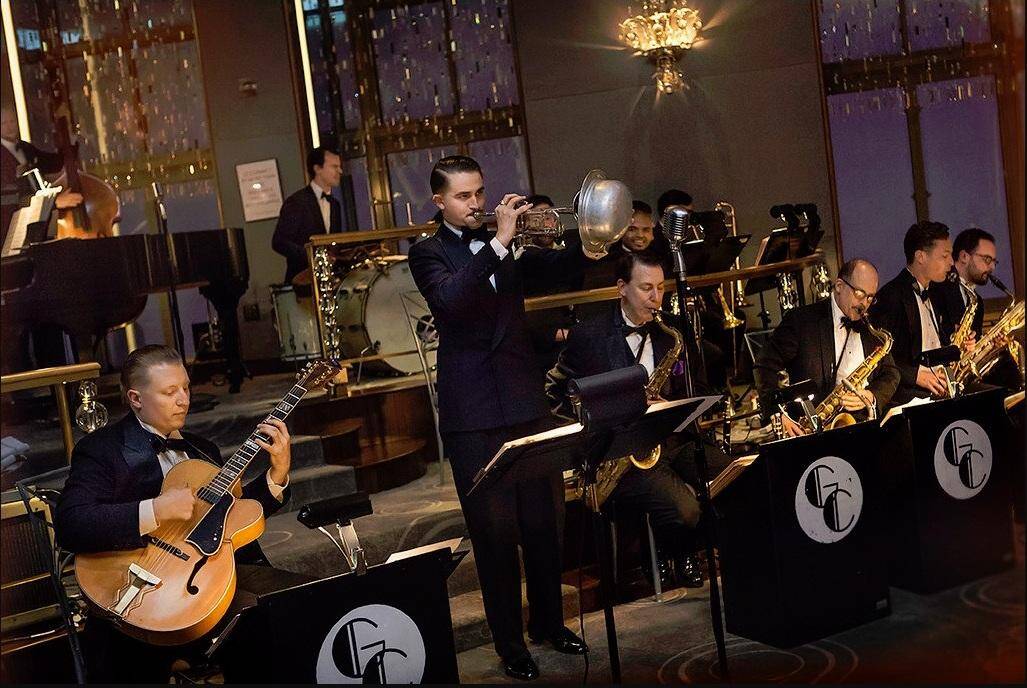One of notable (and somewhat problematic) characteristics of prewar jazz is the finite number of tunes from the era—not that “finite” means “small.” A bandleader might choose from tens of thousands of possible selections to play. The Great American Songbook is not so much a volume as a whole library. “Fine,” a typical leader of a retro big band might say, “We’re all set, then.” And they proceed to swing that music, at times most marvelously.
Bandleader Glenn Crytzer, however, is not content merely to interpret old songs and arrangements, despite their seemingly inexhaustible number. As a composer and arranger, Crytzer performs his own music in seamless and happy juxtaposition with the old favorites. “I want to further a new tradition of writing in the old style.” The classic swing, pop, and jazz forms may have flourished in a particular time and place, but those compositional idioms are not dead. “It’s just a style within which one can write. It’s about taking pop music forms from the twentieth century and making something creative within and putting your own spin on the genre at hand. This is how most jazz musicians thought too. They wanted to swing, they wanted to have their own voices as performers and arrangers.”
Crytzer now plays hot rhythm and solo guitar, as well as tenor banjo, but he didn’t delve into jazz until his mid 20s. A native of Butler, Pennsylvania (35 miles north of Pittsburgh), he studied the cello beginning in grade school and wrote classical compositions from the age of 14. He received his Bachelor’s Degree in Music at Florida State University, and earned his Masters at the Cleveland Institute of Music. He was recognized for his excellence early on, and earned several awards for his compositions, including a BMI Student Composer Award in 2005 for his first piece for full orchestra, “Nocturne Fantasy.”
Swing Dancing and Jazz
As he pursued his studies as a composer and cellist, Glenn Crytzer also developed an interest in swing dancing. This was in the late ’90s, when the Lindy Hop was first regaining some popularity after its post-World War Two decline. There being no YouTube at the time, dancers were learning the basics through fifth-generation dubs of historical dance performances and instructional films on VHS cassettes.
Though some good DJs provided music for the dance events, Crytzer notes “there were no live bands playing authentic vintage-style jazz for the dancers.” By 2005, while working toward his Master’s at the Cleveland Institute, he took up tenor banjo and co-founded The Any Measure Jazz Band, an early jazz ensemble made up of other classical music students.
In 2006, Crytzer took his degree from Cleveland and moved to Seattle, where he worked as music librarian with the Seattle Opera. While editing scores for the various productions mounted by the Opera, he moonlighted as leader of Glenn Crytzer and his Red Hot Syncopators (later simply Glenn Crytzer and his Syncopators). The Syncopators first performed at the long-established Hep Cat Swing Dance in Seattle in June 2007. Crytzer initially concentrated on a repertoire drawn from dixieland jazz and swing music from the late 1920s through the early 1930s.
Syncopators Make a Hit
The Syncopators were a hit with the dancers and were soon booked into dance venues throughout the Seattle area. In 2008, Crytzer branched out from tenor banjo to master orchestral jazz guitar, having decided to explore a swing style more reminiscent of the late 1930s and early 1940s. He also added instrumentation to found Crytzer’s Blue Rhythm Band, a thirteen-piece big band (now known as The Glenn Crytzer Orchestra), which performs the music of the 1920s through 1940s as well as his own songs and arrangements all written in authentic vintage style.
About the time he turned 30, Crytzer decided it was time to stop moonlighting, and said, “I’m going to quit my job and take the leap into being a freelancer.” For the next few years he worked as a musician and bandleader, traveling from his home base in Seattle to gigs and festivals throughout the country. Unfortunately, as those working on the road will tell you, the life of a peripatetic musician has its risks.
In the early morning hours of April 12, 2013, Crytzer was in a van with Solomon Douglas and Douglas’ wife, enroute from Seattle to Iowa City to perform at the Hawkeye Swing Festival. According to Douglas (in an article in the June 2013 issue of The American Rag), “we hit a patch of ice eastbound on I-90 in the middle of South Dakota and rolled my van. It was a pretty spectacular wreck but we all survived. I was driving, Glenn was in the front passenger seat, and my wife Calico Goodrich was in the back seat. When I lost control of the van, we went off the left side of the roadway, through the median, across the lanes of westbound traffic (of which there was thankfully none), and then into the ditch on the north side, where the van rolled once and landed right-side up. The van was totally crushed, but interestingly, all of our gear (drum set, guitar, digital keyboard, audio equipment, luggage) survived with only dirt and cosmetic damage.”
The Big Move
Douglas and Goodrich emerged from the wreck with only minor bruises and cuts, but Glenn Cryzter was laid up in the hospital in Pierre for a week with a severely broken arm. Douglas was able to make the Iowa event, but Crytzer spent months in physical therapy —during which time he decided to move to New York. In the November 2013 American Rag, he said, “Yep, the cat’s out of the bag! I’m moving to NYC in June of 2014! Seattle’s been great to me, but it’s time for a change and I’m excited to move to a new music and dance scene where I’ll meet new friends and colleagues as well as being closer to family!”
Soon after establishing himself in the Apple, Crytzer created New York versions of his various bands—not only The Syncopators and The Blue Rhythm Band, but also the Savoy Seven, a septet recreating the swing combo sound of Benny Goodman, John Kirby, Fats Waller, Artie Shaw, and others. In New York, The Syncopators became The New Yorkers, and he added the Metropolitan Melody Makers (a six- or seven-piece group performing 1920s and early 1930s music), The Second Line Serenaders (a traditional New Orleans-style band), and the Pegu Club All Stars, a quartet which plays every Sunday night at the Pegu Club in SoHo.
Tailoring Charts for Sidemen
As a bandleader-arranger-composer with long-term sidemen like trumpeter Mike Davis and trombonist Matt Musselman, Crytzer often writes charts with specific musicians in mind. “The more I get the opportunity to write for these guys, the more I feel I should just label the band parts ‘Mike’ or ‘Matt’ rather than ‘2nd Trumpet’ or ‘2nd trombone.’” His next project “will be to create original feature pieces for each of the musicians in the big band.”
Glenn and Mike Davis have known each other since the days in Seattle, though “I knew Mike’s mother before I met Mike. His mother was a violinist with the Seattle Opera when I was music librarian.” Davis features prominently on Focus Pocus, an EP of all-original Crytzer compositions recorded in 2013. (All Glenn Cryzter’s CDs are available through www.glenncrytzer.com.)
Cryzter is also very particular about sound, specifically the microphone and amp arrangements in his live performances. He demands minimal microphone placement for a more balanced, true-to-the-period sound—an arrangement that many sound technicians in clubs regard with skepticism, and attempt to subvert. “I’ve walked into a place, holding the contract in my hand that says it has to be this way, and people have tried to sneak microphones onto the stage.” Since “the sound guys never heard this kind of music,” they don’t think Crytzer’s method should work. “And they’re always surprised when it does.”

Technology is not the Enemy
Amplification, however, is not the enemy. It helped musicians develop a lighter touch in the 1930s. “Count Basie was a stride pianist until he was miked. And the technological innovations enabled Teddy Wilson to play in a lighter style.” Jazz, he says, “is the first music that developed alongside technology.” He reflects that singers like Billie Holiday would not have been able to perform without the boost of a microphone.
Regarding another musician whose fame was made possible by technology, “I’m a little sad not to see more news from the mainstream jazz world about Charlie Christian’s centennial this year.” Crytzer observes Charlie Christian‘s hundredth birthday anniversary with a Savoy Seven concert at Zinc Bar in New York on July 28. “Every guitarist to ever pick up the instrument is indebted to Charlie Christian, not only for his bringing of the instrument to prominence as a solo voice, but in the vocabulary and technique he pioneered on the instrument.” The Savoy Seven will recreate the sound of Benny Goodman and his Sextet, which showcased Christian as a solo artist.

Doubling the Band’s Book
Glenn Crytzer considers himself a good rhythm player and a solid soloist, but believes his main focus is as a director, arranger, and composer. His originals are being received favorably by his New York audiences. “It’s exciting when I hear people singing along with one of my own songs, and even requesting my originals.”
And while he’s still searching for a new venue for his Vintage Big Band Mondays (there was a fire at his previous home base, the Fillmore Room, in April), he’s been hard at work doubling the size of the band’s repertoire. “I have a hundred charts in the book for the big band. My goal is to have at least two hundred new arrangements transcribed by the end of the summer.”
“It’s a tall goal,” says Glenn Crytzer.
Further Reading:
By Glenn
Glenn Crytzer: On Programming an Album of Original Swing Music
A History of the Music Business and Where it’s Headed Now
Album Reviews
The Glenn Crytzer Orchestra Ain’t it Grand? (Double CD)
The Glenn Crytzer Orchestra: Ain’t It Grand?
Glenn Crytzer Orchestra • Underneath The Mistletoe
Glenn Crytzer’s Secluded Seven: The Melody That Follows Me
Andy Senior is the Publisher of The Syncopated Times and on occasion he still gets out a Radiola! podcast for our listening pleasure.






















